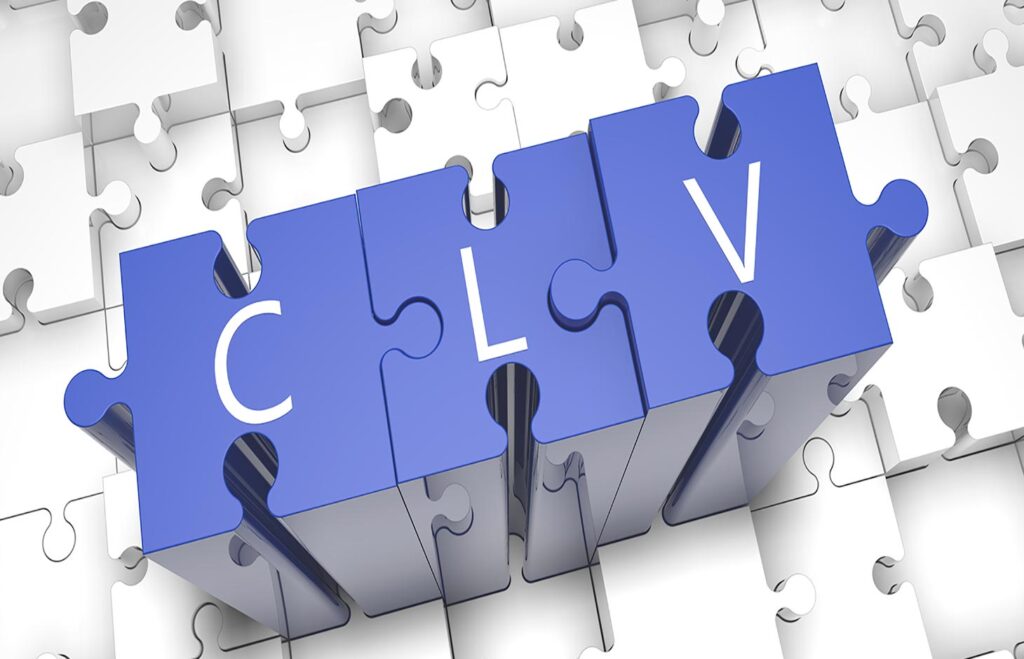Even in the best business relationships, there’s usually a finite amount of revenue you can expect to collect from each customer. The common metric to calculate this is called your “customer lifetime value”, and there are a few ways you can calculate it.
The most simplistic way is to take the average amount of money a customer spends with your business and multiply that by the average amount of time a customer does business with you.
Average Customer Spend x Average Customer Lifespan = CLTV
And then there are more accurate formulas, such as the one below. These methods better account for the expenses your business incurs delivering your product, such as your customer acquisition cost, product development, labor, etc.
Average Customer Lifespan x (Average Customer Spend x Profit Margin)
This other method often results in a much lower customer lifetime value figure. But, it also provides you with a much more realistic way to forecast your future revenue and cash flow.
Regardless of how you choose to do the math, one fact remains the same: the higher your customer lifetime value, the better your MRR will be. And of course, consistent MRR growth is key to SaaS success.
1. Use strategic SaaS selling to create longer customer lifecycles
Put yourself in the shoes of a prospective customer.
You’ve considered the sales materials, heard all the pitches, and you like what you see. The product seems great, the people seem trustworthy, but still, the price is just too restrictive. And the business isn’t willing to offer you that half-off discount you’d need in order to bite. What do you do?
If you’re like many customers, you’ll probably wind up opting for a product that’s more suitable to your budget at the moment.
The problem with this scenario is while that budget-product may fulfill the customer’s needs now, what about next year, and the year after that? It’s time to take the customer from what it will cost them today to what it will cost them in the years ahead.
Being a little more strategic about your discounting is a great way to win over customers worried about the cost of your product without undercutting your own value.
By extending more reasonable discounting over the first several years of a contract, you can lock in a longer-term contract while providing the customer with a more transparent cost of ownership.
For example, instead of caving to that 50% discount your customer wants for a one-year contract, suggest this:
- 30% off year one
- 20% off year two, and
- 15% off year three.
For your business: Moderate, diminishing discounts over a several-year contract makes you more revenue upfront—a safer strategy in case the customer decides to churn earlier than expected—while laying the foundation for a much longer business relationship.
For the customer: Not only can they be confident in their cost of ownership for the next three years, but they also know they won’t have to go through the difficult process of replacing their software anytime soon.
The only downside?
Creative discounting is complicated for businesses that haven’t digitally transformed their billing processes. For example, with a legacy billing system, these gradual customer price changes will need to be adjusted on time and perhaps manually. This creates a significant amount of work and the potential for costly human errors.
With an adaptive subscription billing platform, you automate the kinds of creative discounts that promote longer contracts and greater customer lifetime value.
2. Build in expansion MRR from the beginning
Price increases can be something of a double-edged sword when it comes to the lifetime value of a customer. On one hand, the more you charge, the more money you make. On the other hand, if the process is handled sloppily, you may lose customer revenue to churn.
In the world of SaaS, annual price uplifts are common. In fact, not doing it can cause you to fall behind the competition.
One of the best ways to handle uplifts is to be as transparent as possible from the get-go.
- Lay it out clearly: Make it clear in all your contracts that your customers will pay X amount in year one, with an X percentage uplift every year after that. No surprises.
- Give advance notice: People forget anyway, and no one likes a surprise when it comes to their bills. Remind your customers when their scheduled price uplifts are set to take effect.
- Automate everything: A lot of businesses forgo uplifts because of the effort required to manage and update price changes across their entire customer base. This is a missed revenue opportunity. An adaptive recurring billing platform lets you automate price uplifts (as well as providing uplift reminders) so you never have to worry about it again.
This process helps you increase your MRR by building long-term growth into your contracts. And by managing it properly, you reduce the risk of price-increase-related customer churn.
3. Keep reminding your customers why they chose you
No one wants their day to be flooded with messages—not even from a business they love as much as yours. However, it can be equally (or nearly equally) frustrating for a customer if they never hear from you again after their sale closes.
Strike a careful balance. By reaching out in ways and at milestones that are useful to the customer, you position yourself for a long, successful relationship.
- Onboarding: Customers are most likely to churn in the early stages of using your product. Why? Because if they aren’t achieving their desired outcome, they’re probably going to go somewhere else before they get too invested in your product. Proper onboarding communication management can help solve that problem.
- Update notifications: Software updates can change the customer experience and help them achieve greater success. Notifications and in-app tutorials help the process go smoothly, while also reminding the customer of the value of your product.
- Courtesy: You may also send occasional courtesy emails. For example, if you notice a client’s credit card is about to expire, it could be helpful to notify them a month or two in advance. They may appreciate the reminder, and it can also go a long way toward preventing involuntary churn.
The happier your customers are with your product and service, the longer they’ll stay on. Oftentimes, it’s as simple as that!
4. Be available when your SaaS customers need you most
Around 96% of consumers say the customer experience is an important component of who they decide to do business with. When something is a rounding error away from being unanimous, it’s worth paying attention to.
Depending on the size of your operation, you may not always be able to respond to situations or make necessary bug fixes in real-time. However, it’s still possible to make a customer happy, even when they have to wait a little while for an actual solution.
Acknowledging requests with a simple, professional message will show the customer they’ve been heard and they’re being taken seriously. Consequently, they may feel a little more patient if they wind up waiting for a day or two.
And over time, quick, consistent acknowledgement and follow-up action helps build loyalty from customers who feel they’re supported and appreciated.
5. Upsell when the time is right
When done correctly, an upsell can feel more like a helpful suggestion than a pitch. Take iCloud as an example.
Users of iCloud can choose from a range of different storage plan sizes. When users’ storage needs begin to outgrow the plans they’ve implemented, iCloud gently suggests upgrading the plan.
This technique works because the suggestion is legitimately useful to the buyer. They don’t want to lose their data, so the solution is to spend a little bit more money on a plan upgrade.
For many SaaS businesses, suggesting feature upgrades can be a great way to prove you understand your client’s needs. And of course, it’ll also increase your MRR and CLTV.
However, that doesn’t mean you can start thinking of your current customer roster as an open piggy bank. Timing is everything.
If you can get to know your customers and suggest new features they actually need, you’ll:
- build expansion MRR
- build brand loyalty, and
- increase your CLTV in the process.
However, blindly throwing out any and every promotional opportunity will have the opposite effect.
At best, your customers will stop reading your messages. Only about 15% of emails get opened at all, so if you start becoming bothersome, you might find your way into the dreaded “ignore” pile.
Worse yet, you may even introduce the possibility of customer churn. Poor communication is consistently ranked as one of the top causes of churn, so it’s best to upsell sparingly and strategically.
Symbiotic SaaS relationships lead to higher MRR and longer CLTV
It’s easy to forget about your customers once you’ve made the sale. But in doing so, you leave money on the table.
By considering the customer lifetime value on the front end of a sale and then throughout the entire customer journey, you not only increase your MRR, retention, and CLTV, but you also treat your customers to a better long-term experience.
People like to work with people they like.
When done right, the relationship between a SaaS business and its customers can be symbiotic. Long-term relationships result in a smooth, reliable experience for the buyer and consistent, recurring revenue for the business.
It’s a win-win for everyone!








